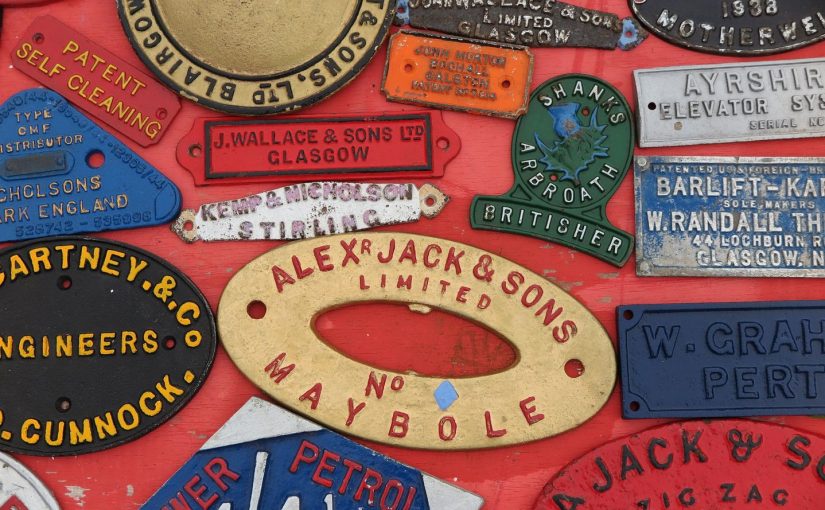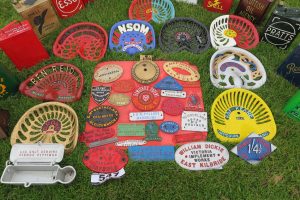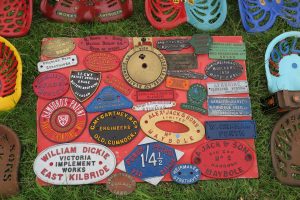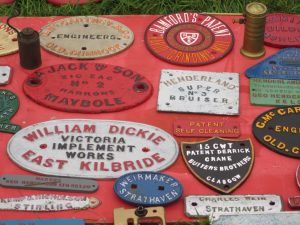Only a small number of the Scottish agricultural implement and machine makers exhibited at the Royal Show of the Royal Agricultural Society of England. When they did, they were exhibiting their most important implements and machines that would attract the English market. They also exhibited their most innovative ones. Sometimes they also entered them for the Society’s medals, the award of which was prestigious and could have a significant impact on the reputation of a maker.
In 1893 there were significant advances being made in the development of weighing machines and milking machines. Scottish makers such as Alex Wood & Sons, Glasgow, J. D. McJannet, Woodlands, Stirling, and Mr John Gray, Stranraer, took their manufactures to the show to enter them for awards and to get wider recognition for their manufactures. Other manufacturers also took their well-renowned implements and machines.
The Scotsman newspaper usually provided extensive accounts of the Scottish exhibitors to the Royal. It did so in 1893, providing a comprehensive review of their exhibits. This is what it wrote in its issue of 19 June 1893:
“At Chester
There are less than a dozen Scottish implement makers represented, but those who are forward make a very creditable appearance, considering the expense that is involved in the conveyance of a large collection of heavy implements. Taking the exhibitors from the north of the Tweed in the order in which they appear in the catalogue, the first stand is that of Messrs Alex Wood & Sons, Glasgow, who have an excellent display of those weighing machine for the manufacture of which they have gained a high reputation. Two of their machines are entered for the Society’s medals, one being the “Wynyard” cattle weighing machine. It has a strong iron pen with double leaf gates at each end, and a dial graduated from 3 ½ lb to 30 cwts, and constructed entirely on the lever principle. Another notable exhibit is what is called the “Smithfield” weighing machine for carts, cattle &c. It is fitted with an adjustable pen, which in about a minute can be altered for either carts or cattle. By a simple arrangement the side gates of the pen are merely folded back against the end gate, and the widest hay cart may then be drawn over the breadth of the weighing machine. Several other admirably contrived weighing machines are shown on this stand. Close by, Mr J. D. McJannet, Woodlands, Stirling, who has done so much to popularise the “block test” in Scotland, exhibits a weighbridge for carts and cattle, together with a cattle cage, both having the appearance of substantial workmanship and simplicity of construction.
Among a neat and useful collection of dairy utensils, Mr John Gray, Stranraer, shows Nicholson & Gray’s patent milking machine, which in 1891, when it was first exhibited at work in public, was awarded medals at the Royal Society’s Show at Doncaster, the Highland Society’s Show at Stirling, and the London Dairy Show. Since then some further improvements have been effected on the machine, and it is shown here in portable form, for small dairies, and arranged for two or four cows. The horn of which the teat-cups are made are now transparent, so that the person in charge may see the milk flowing into the can. An inflated tongue has also been inserted in the mouth of the cup to imitate, as near as possible, the action of the natural calf in sucking, and this ingenious arrangement pressing against the teat causes the cow to give her milk more freely. The degree of perfection to which this invention has now been brought would seem to give it a strong claim on the attention of dairy farmers in this country as well as abroad, where it has already been received with considerable favour. Messrs Carrick & Ritchie, Waverley Engineering Works, Edinburgh, show several of their well-known turbines, one of these being combined with a dynamo, and specially adapted for lighting country mansions, or for transmitting power to drive farm or other machinery situated at a distance from the water power.
Messrs John Wallace & Sons, Glasgow, show a number of American chilled ploughs, mowers and reapers, and potato diggers. Some useful implements are exhibited by Messrs Ben Reid & Co., Aberdeen, chief among them being a thrashing machine, fitted with shakers and blast, and having an elevator attached for bagging the grain. By an improved gearing the speed is got up inside the barn as well as outside, and an easier motion is secured. The other articles on this stand include drills, broadcast sowers, manure distributors, grubbers, and pumps. Mr William Elder, Berwick-on-Tweed, has, as usual, a varied assortment of implements of practical value on the farm. His broadcast sowing machine has the advantage of being able to go through ordinary gateways by having the box arranged on a swivel, so that it can be swung round without disconnecting the gearing. The seed-box has been enlarged, and is fitted with six divisions, so that the seed will not fall to the end of the box when sowing along hillsides. His turnip and mangold sower will sow eight different quantities of seed, and a regular and continuous delivery is obtained. There are about a score of other articles on the stand, and they are varied and well selected to meet the wants of farmers. Ayrshire is, as usual, well represented by Mr Thos Hunter, Maybole, with a highly meritorious collection of hoes, cultivators, grubbers, harrows, and root cleaners; and Messrs Alex Jack & Sons, from the same town, have also a neat display, including their “Caledonian Buckeye” mowers and reapers, their beautifully made farm carts, turnip and mangold drills, horse rakes, and an improved potato raiser with the gearing enclosed.”
Quite a display by all accounts!




